Assessing Alternative Silvicultural Prescriptions for Mid-Rotation, Unthinned, Spruce-Fir Stands in Maine
Abstract
:1. Introduction
2. Materials and Methods
2.1. Study Sites
2.2. Growth and Yield
2.3. Product Merchandising
2.4. Harvest Costs and Revenues
2.5. Analytical Approach
3. Results
3.1. The Effect of Treatment on Maximum NPV
3.2. The Effect of Treatment on Stand Age at Time of Maximum NPV
3.3. The Effect of Treatment on Average Merchantable Stem Size
3.4. Sensitivity of Net Present Value to Interest Rate
4. Discussion
4.1. Commercial Thinning Effects
4.2. Effect of Thinning Method
4.3. Thinning Effect on Average Merchantable Stem Size
4.4. Limitations
5. Conclusions
Acknowledgments
Author Contributions
Conflicts of Interest
References
- McCaskill, G.L.; McWilliams, W.H.; Barnett, C.J.; Butler, B.J.; Hatfield, M.A.; Kurtz, C.M.; Morin, R.S.; Moser, W.K.; Perry, C.H.; Woodall, C.W. Maine’s Forests 2008; U.S. Department of Agriculture Forest Service, Northern Research Station: Newtown Square, PA, USA, 2011.
- Jin, S.; Sader, S.A. Effects of forest ownership and change on forest harvest rates, types and trends in northern Maine. For. Ecol. Manag. 2006, 228, 177–186. [Google Scholar] [CrossRef]
- Seymour, R.S. The red spruce-balsam fir forest of Maine: Evolution of silvicultural practice in response to stand development patterns and disturbances. In The Ecology and Silviculture of Mixed-Species Forests. A Festschrift for David M. Smith; Kelty, M.J., Larson, B.C., Oliver, C.D., Eds.; Kluwer Publishers: Norwell, MA, USA, 1992; pp. 217–244. [Google Scholar]
- Irland, L.C.; Dimon, J.B.; Baum, E.; Falk, J.; Stone, J.L. The Spruce Budworm Outbreak in Maine in the 1970’s—Assessment and Directions for the Future; Maine Agricultural Experiment Station: Orono, ME, USA, 1988. [Google Scholar]
- Hiesl, P.; Benjamin, J.G.; Roth, B.E. Evaluating harvest costs and profit of commercial thinnings in softwood stands in west-central Maine: A Case Study. For. Chron. 2015, 91, 150–160. [Google Scholar] [CrossRef]
- Zhang, S.; Chauret, G.; Tong, Q. Impact of precommercial thinning on tree growth, lumber recovery and lumber quality in Abies balsamea. Scand. J. For. Res. 2009, 24, 425–433. [Google Scholar] [CrossRef]
- Zeide, B. Thinning and growth: A full turnaround. J. For. 2001, 99, 20–25. [Google Scholar]
- Smith, D.M. The Practice of Silviculture, 8th ed.; John Wiley & Sons, Inc.: New York, NY, USA, 1986. [Google Scholar]
- Nyland, R.D. Silviculture: Concepts and Applications, 2nd ed.; McGraw-Hill: New York, NY, USA, 2002. [Google Scholar]
- Weiskittel, A.R.; Kenefic, L.S.; Li, R.; Brissette, J. Stand structure and composition 32 years after precommercial thinning treatments in a mixed northern conifer stand in central Maine. North. J. Appl. For. 2011, 28, 92–96. [Google Scholar]
- Prévost, M.; Gauthier, M.M. Precommercial thinning increases growth of overstory aspen and understory balsam fir in a boreal mixedwood stand. For. Ecol. Manag. 2012, 278, 17–26. [Google Scholar] [CrossRef]
- Pitt, D.G.; Lanteigne, L.; Hoepting, M.K.; Plamondon, J. Effects of precommercial thinning on the forest value chain in northwestern New Brunswick: Part 1—Roundwood production and stumpage value. For. Chron. 2013, 89, 446–457. [Google Scholar] [CrossRef]
- Clune, P.M. Growth and Development of Maine Spruce-Fir Forests Following Commercial Thinning. Master’s Thesis, University of Maine, Orono, ME, USA, 2013. [Google Scholar]
- Reukema, D.L.; Bruce, D. Effects of Thinning on Yield of Douglas-Fir: Concepts and Some Estimates Obtained by Simulation; U.S. Department of Agriculture Forest Service, Pacific Northwest Research Station: Portland, OR, USA, 1977.
- Pekol, J.R. The Influence of Commercial Thinning on Stand- and Tree-Level Mortality Patterns of Balsam Fir (Abies balsamea) and Red Spruce (Picea rubens) Forests in Maine that Have or Have Not Received Precommercial Thinning. Master’s Thesis, University of Maine, Orono, ME, USA, 2011. [Google Scholar]
- Mäkinen, H.; Isomäki, A. Thinning intensity and growth of Scots pine stands in Finland. For. Ecol. Manag. 2004, 201, 311–325. [Google Scholar] [CrossRef]
- Mäkinen, H.; Isomäki, A. Thinning intensity and growth of Norway spruce stands in Finland. Forestry 2004, 77, 349–364. [Google Scholar] [CrossRef]
- Hiesl, P.; Crandall, M.S.; Weiskittel, A.; Benjamin, J.G.; Wagner, R.G. Evaluating the long-term influence of alternative commercial thinning regimes and harvesting systems on projected net present value of precommercially thinned spruce—Fir stands in northern Maine. Can. J. For. Res. 2017, 47, 203–214. [Google Scholar] [CrossRef]
- Zon, R. Balsam Fir; U.S. Department of Agriculture: Washington, DC, USA, 1914.
- Murphy, L.S. The Red Spruce: Its Growth and Management; U.S. Department of Agriculture: Washington, DC, USA, 1917.
- Fowells, H.A. Silvics of Forest Trees of the United States; U.S. Department of Agriculture: Washington, DC, USA, 1965.
- Wagner, R.G.; Bryant, J.; Burgason, B.; Doty, M.; Roth, B.E.; Strauch, P.; Struble, D.; Denico, D. Coming Spruce Budworm Outbreak: Initial Risk Assessment and Preparation & Response Recommendations for Maine’s Forestry Community; Cooperative Forestry Research Unit, University of Maine: Orono, ME, USA, 2016. [Google Scholar]
- Cary, A. On the growth of spruce. In Second Annual Report of the Forest Commissioner of the State of Maine; Burleigh & Flynt: Augusta, ME, USA, 1894; pp. 20–36. [Google Scholar]
- Leak, W.B. Age distribution in virgin red spruce and northern hardwoods. Ecology 1975, 56, 1451–1454. [Google Scholar] [CrossRef]
- Wagner, R.G.; Seymour, R.S. Commercial Thinning Research Network. In Cooperative Forestry Research Unit 2000 Annual Report; Griffin, H.E., Ed.; University of Maine: Orono, ME, USA, 2000; pp. 21–27. [Google Scholar]
- Wagner, R.G.; Seymour, R.S.; McConville, D.J. Commercial Thinning Research Network. In Cooperative Forestry Research Unit 2001 Annual Report; Griffin, H.E., Ed.; University of Maine: Orono, ME, USA, 2001; pp. 23–35. ISBN 4055220189. [Google Scholar]
- Bataineh, M.M.; Wagner, R.G.; Weiskittel, A.R. Long-term response of spruce–fir stands to herbicide and precommercial thinning: Observed and projected growth, yield, and financial returns in central Maine, USA. Can. J. For. Res. 2013, 43, 385–395. [Google Scholar] [CrossRef]
- DeRose, R.J.; Seymour, R.S. Patterns of leaf area index during stand development in even-aged balsam fir—Red spruce stands. Can. J. For. Res. 2010, 40, 629–637. [Google Scholar] [CrossRef]
- Wilson, D.S.; Seymour, R.S.; Maguire, D.A. Density management diagram for northeastern red spruce and balsam fir forests. North. J. Appl. For. 1999, 16, 48–56. [Google Scholar]
- Briggs, R.D. Site Classification; Maine Agricultural and Forest Experiment Station: Orono, ME, USA, 1994. [Google Scholar]
- Weiskittel, A.R.; Russell, M.B.; Wagner, R.G.; Seymour, R.S. Refinement of the Forest Vegetation Simulator Northeast variant growth and yield model: Phase III. In Cooperative Forestry Research Unit 2011 Annual Report; Roth, B.E., Ed.; University of Maine: Orono, ME, USA, 2012; pp. 85–93. [Google Scholar]
- Weiskittel, A.R.; Kershaw, J.A., Jr.; Crookston, N.L.; Hennigar, C.R. The Acadian Variant of the Forest Vegetation Simulator: Continued development and evaluation. In Proceedings of the 2017 Forest Vegetation Simulator (FVS) e-Conference; Keyser, C., Keyser, T., Eds.; U.S. Department of Agriculture Forest Service, Southern Research Station: Asheville, NC, USA, 2017; pp. 10–13. [Google Scholar]
- Kuehne, C.; Weiskittel, A.R.; Wagner, R.G.; Roth, B.E. Development and evaluation of individual tree- and stand-level approaches for predicting spruce-fir response to pre- and commercial-thinning in Maine, USA. For. Ecol. Manag. 2016, 376, 84–95. [Google Scholar] [CrossRef]
- Weiskittel, A.R.; Hennigar, C.; Kershaw, J.A., Jr. Extending the Acadian variant of FVS to managed stands. In Cooperative Forestry Research Unit 2014 Annual Report; Wagner, R.G., Ed.; University of Maine: Orono, ME, USA, 2015; pp. 47–51. [Google Scholar]
- R Core Team. R: A Language and Environment for Statistical Computing; R Foundation for Statistical Computing: Vienna, Austria, 2015. [Google Scholar]
- Hutchinson, S.F. Evaluating Variation in Commercial Timber and Land Value for Parcels in the Northeast United States. Master’s Thesis, University of Maine, Orono, ME, USA, 2014. [Google Scholar]
- Weiskittel, A.; Li, R. Development of regional taper and volume equations: Hardwood species. In Cooperative Forestry Research Unit 2011 Annual Report; Roth, B.E., Ed.; University of Maine: Orono, ME, USA, 2012; pp. 87–95. [Google Scholar]
- Li, R.; Weiskittel, A.; Dick, A.R.; Kershaw, J.A., Jr.; Seymour, R.S. Regional stem taper equations for eleven conifer species in the Acadian Region of North America: Development and Assessment. North. J. Appl. For. 2012, 29, 5–14. [Google Scholar] [CrossRef]
- Maine Forest Service. 2000 Stumpage Prices; Department of Conservation—Maine Forest Service: Augusta, ME, USA, 2001.
- Maine Forest Service. 2001 Stumpage Prices; Department of Conservation—Maine Forest Service: Augusta, ME, USA, 2002.
- Maine Forest Service. 2002 Stumpage Prices; Maine Department of Conservation—Maine Forest Service: Augusta, ME, USA, 2003.
- Hiesl, P.; Benjamin, J.G. Estimating processing times of harvesters in thinning operations in Maine. For. Prod. J. 2015, 65, 180–186. [Google Scholar] [CrossRef]
- Hiesl, P.; Benjamin, J.G. Harvesting Equipment Cycle Time and Productivity Guide for Logging Operations in Maine; Maine Agricultural and Forest Experiment Station: Orono, ME, USA, 2013. [Google Scholar]
- Benjamin, J.G.; Seymour, R.S.; Meacham, E.; Wilson, J.S. Impact of whole-tree and cut-to-length harvesting on postharvest condition and logging costs for early commercial thinning in Maine. North. J. Appl. For. 2013, 30, 149–155. [Google Scholar] [CrossRef]
- Koirala, A.; Kizha, A.R.; Roth, B.E. Perceiving major problems in forest products transportation by trucks and trailers: A cross-sectional survey. Eur. J. For. Eng. 2017, 3, 23–34. [Google Scholar]
- Row, C.; Kaiser, H.F.; Sessions, J. Discount rate for long-term forest service investments. J. For. 1981, 79, 367–376. [Google Scholar]
- Saunders, M.R.; Wagner, R.G.; Seymour, R.S. Thinning Regimes for Spruce-Fir Stands in the Northeastern United States and Eastern Canada; Cooperative Forestry Research Unit: Orono, ME, USA, 2008. [Google Scholar]
- Randolph, K.C.; Seymour, R.S.; Wagner, R.G. ThinME: User’s Guide; University of Maine: Orono, ME, USA, 2001. [Google Scholar]
- Emmingham, W.; Fletcher, R.; Fitzgerald, S.; Bennett, M. Comparing tree and stand volume growth response to low and crown thinning in young natural Douglas-fir stands. West. J. Appl. For. 2007, 22, 124–133. [Google Scholar]
- Pelletier, G.; Pitt, D.G. Silvicultural responses of two spruce plantations to midrotation commercial thinning in New Brunswick. Can. J. For. Res. 2008, 38, 851–867. [Google Scholar] [CrossRef]
- Mäkinen, A.; Kangas, A.; Kalliovirta, J.; Rasinmäki, J.; Välimäki, E. Comparison of treewise and standwise forest simulators by means of quantile regression. For. Ecol. Manag. 2008, 255, 2709–2717. [Google Scholar] [CrossRef]
- Chen, C.; Weiskittel, A.R.; Bataineh, M.M.; MacLean, D. Evaluating the influence of varying levels of spruce budworm defoliation on annualized individual tree growth and mortality in Maine, USA and New Brunswick, Canada. For. Ecol. Manag. 2017, 396, 184–194. [Google Scholar] [CrossRef]
- Fraver, S.; White, A.S. Disturbance dynamics of old-growth Picea rubens forests of northern Maine. J. Veg. Sci. 2005, 16, 597–610. [Google Scholar] [CrossRef]
- Fraver, S.; White, A.S.; Seymour, R.S. Natural disturbance in an old-growth landscape of northern Maine, USA. J. Ecol. 2009, 97, 289–298. [Google Scholar] [CrossRef]
- Randolph, K.C.; Seymour, R.S.; Wagner, R.G. ThinME: Development of Commercial Thinning Guidelines for Maine Spruce-Fir Forests; University of Maine: Orono, ME, USA, 2002. [Google Scholar]
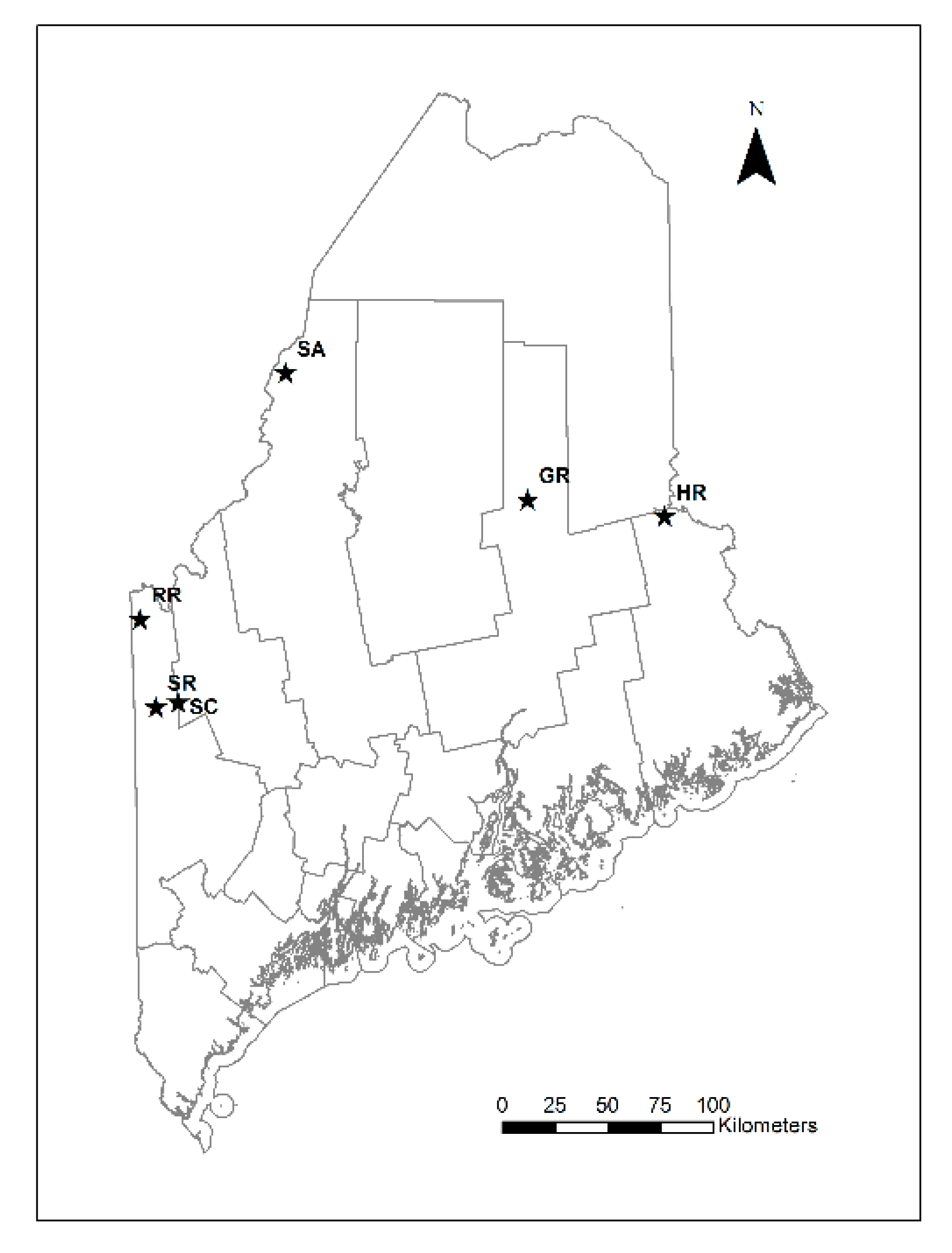
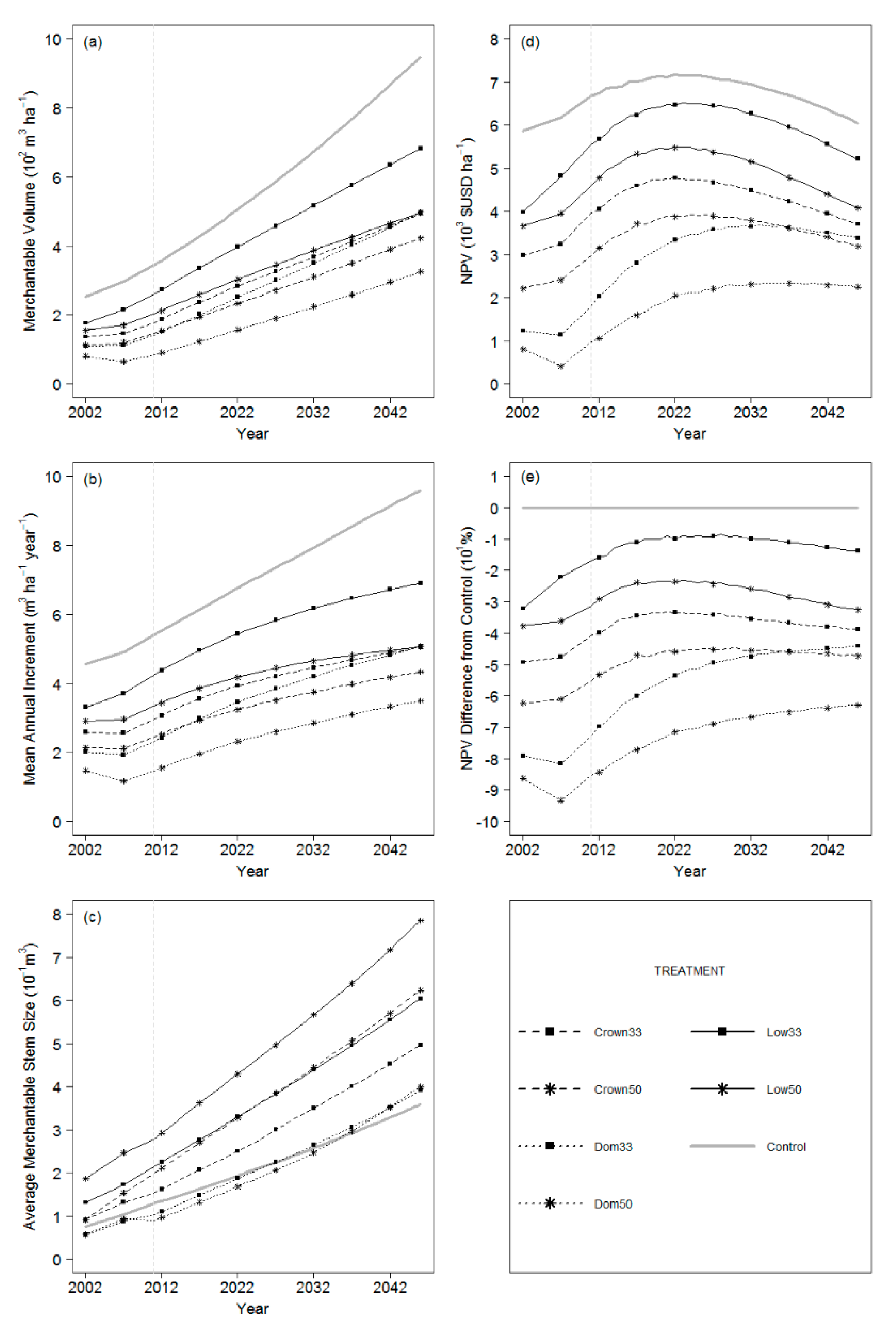

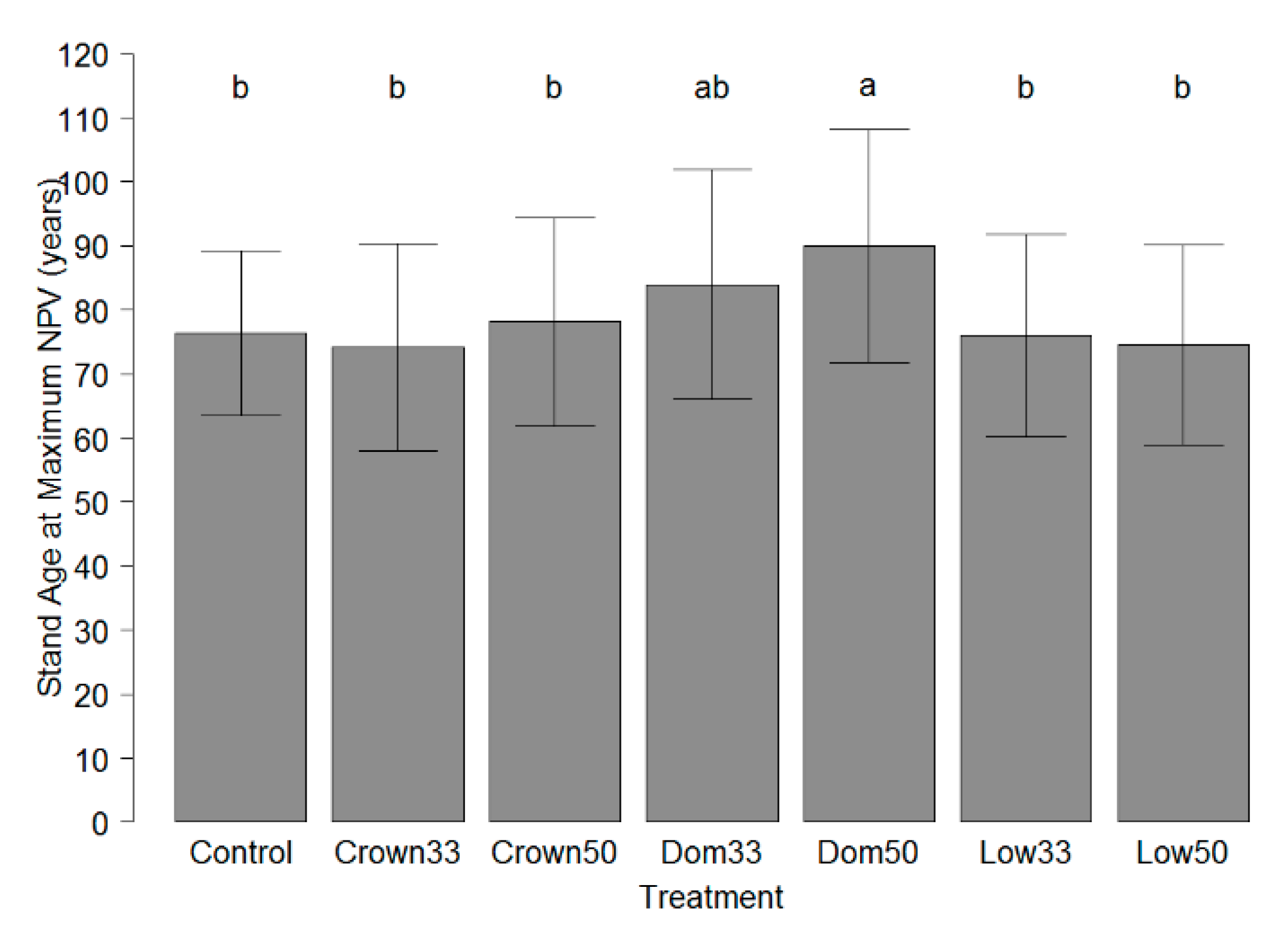
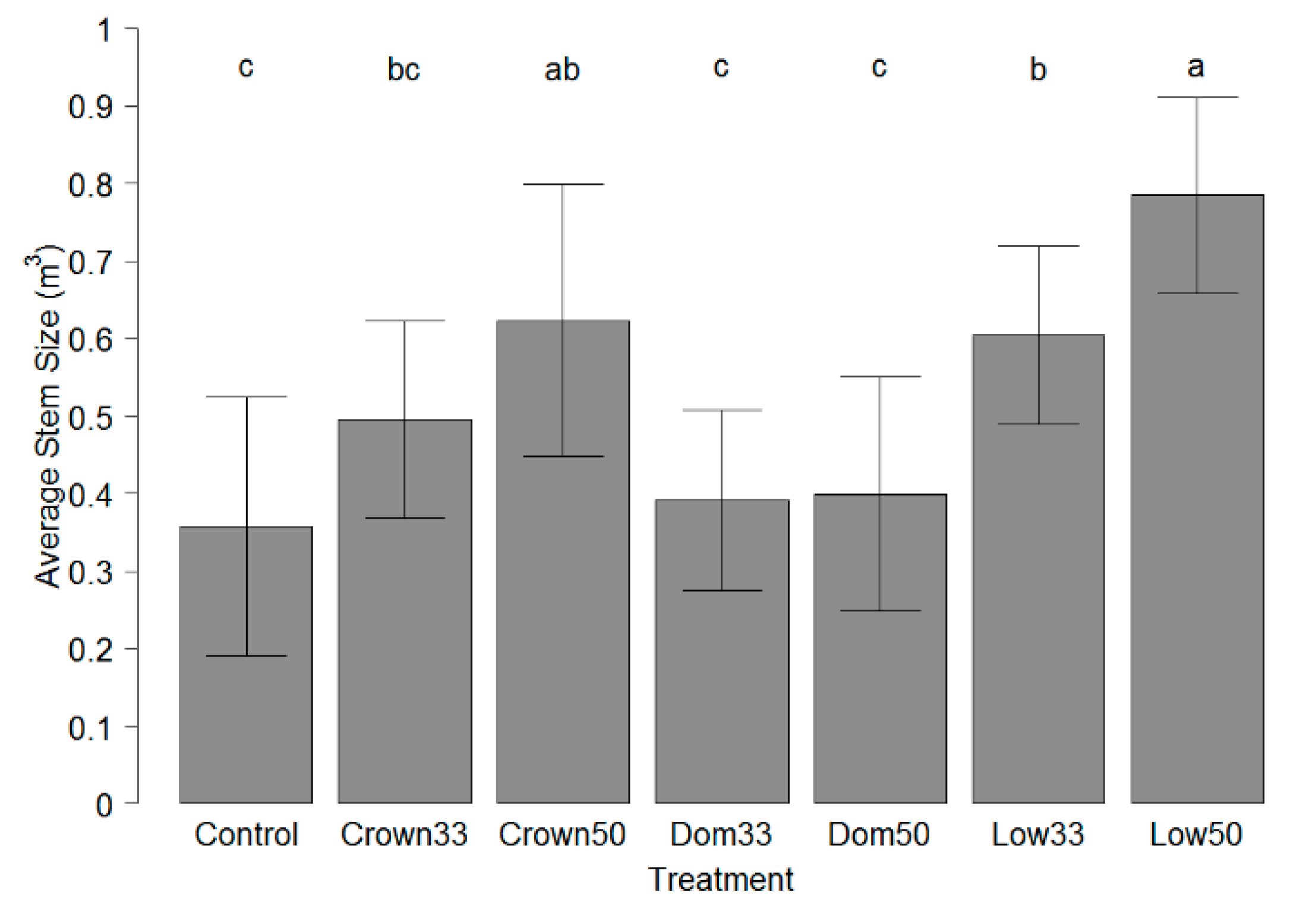
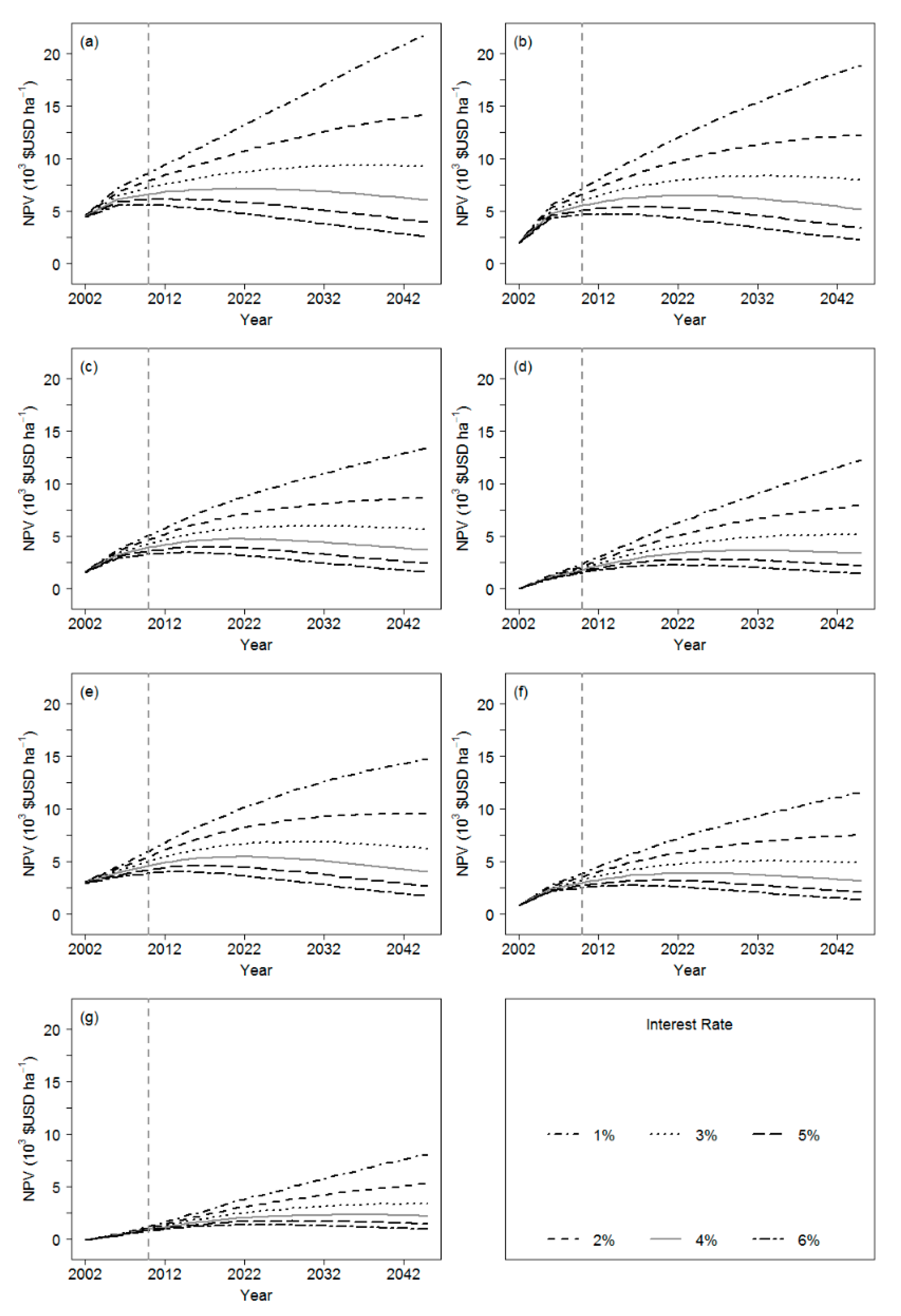
| Treatment | Description |
|---|---|
| Crown33 | Crown thinning with 33% relative density reduction |
| Crown50 | Crown thinning with 50% relative density reduction |
| Dom33 | Dominant thinning with 33% relative density reduction |
| Dom50 | Dominant thinning with 50% relative density reduction |
| Low33 | Low thinning with 33% relative density reduction |
| Low50 | Low thinning with 50% relative density reduction |
| Control | Unthinned |
| Site Name | BH Age (years) a | Elevation (m) | Aspect (°) | Briggs Site Class b | Site Index (m) c | Year of CT d | TPH e | BA f (m2 ha−1) | QMD g (cm) |
|---|---|---|---|---|---|---|---|---|---|
| Golden Road (GR) | 57 | 145–149 | 230 | 2 | 12.9 | 2000 | 3115 | 38.8 | 12.7 |
| Harlow Road (HR) | 70 | 154–155 | 150 | 4 | 12.1 | 2002 | 2072 | 40.2 | 15.7 |
| Rump Road (RR) | 40 | 640–652 | 122 | 4 | 16.4 | 2002 | 5834 | 45.9 | 9.9 |
| St. Aurelie (SA) | 34 | 415–422 | 92 | 4 | 17.6 | 2001 | 5727 | 39.0 | 9.4 |
| Schoolbus Road (SC) | 65 | 521–529 | 140 | 4 | 13.2 | 2001 | 3470 | 47.3 | 13.2 |
| Sarah’s Road (SR) | 54 | 475–485 | 159 | 2 | 12.6 | 2001 | 4404 | 48.2 | 12.2 |
| CT Year | Pulpwood $ m−3 | Studwood $ m−3 | Sawlogs $ m−3 | Hemlock Sawlogs $ m−3 |
|---|---|---|---|---|
| 2000a | 8.70 | 15.66 | 26.93 | 10.51 |
| 2001b | 8.28 | 16.53 | 23.61 | 10.15 |
| 2002c | 7.46 | 12.18 | 23.40 | 9.79 |
| Fixed Effects | Random Effects | |||||||
|---|---|---|---|---|---|---|---|---|
| n | df | F value | p value | Variable | SD | Variance | % Explained | |
| (a) Maximum NPV | ||||||||
| Intercept | 1 | 30 | 137.831 | <0.001 | SITE | 881.937 | 777,813 | 28 |
| Treatment | 6 | 30 | 8.470 | <0.001 | PLOT (in SITE) | 1327.377 | 1,761,930 | 62 |
| Residual | 532.820 | 283,897 | 10 | |||||
| (b) Stand Age at Time of Maximum NPV | ||||||||
| Intercept | 1 | 30 | 160.489 | <0.001 | SITE | 15.122 | 229 | 87 |
| Treatment | 6 | 30 | 6.172 | <0.001 | PLOT (in SITE) | 5.062 | 26 | 10 |
| Residual | 2.795 | 8 | 3 | |||||
| (c) Average Merchantable Stem Size | ||||||||
| Intercept | 1 | 30 | 153.455 | <0.001 | SITE | 0.095 | 0.009 | 45 |
| Treatment | 6 | 30 | 13.305 | <0.001 | PLOT (in SITE) | 0.096 | 0.009 | 46 |
| Residual | 0.041 | 0.002 | 9 | |||||
© 2017 by the authors. Licensee MDPI, Basel, Switzerland. This article is an open access article distributed under the terms and conditions of the Creative Commons Attribution (CC BY) license (http://creativecommons.org/licenses/by/4.0/).
Share and Cite
Hiesl, P.; Crandall, M.S.; Weiskittel, A.R.; Kizha, A.R. Assessing Alternative Silvicultural Prescriptions for Mid-Rotation, Unthinned, Spruce-Fir Stands in Maine. Forests 2017, 8, 370. https://doi.org/10.3390/f8100370
Hiesl P, Crandall MS, Weiskittel AR, Kizha AR. Assessing Alternative Silvicultural Prescriptions for Mid-Rotation, Unthinned, Spruce-Fir Stands in Maine. Forests. 2017; 8(10):370. https://doi.org/10.3390/f8100370
Chicago/Turabian StyleHiesl, Patrick, Mindy S. Crandall, Aaron R. Weiskittel, and Anil R. Kizha. 2017. "Assessing Alternative Silvicultural Prescriptions for Mid-Rotation, Unthinned, Spruce-Fir Stands in Maine" Forests 8, no. 10: 370. https://doi.org/10.3390/f8100370





